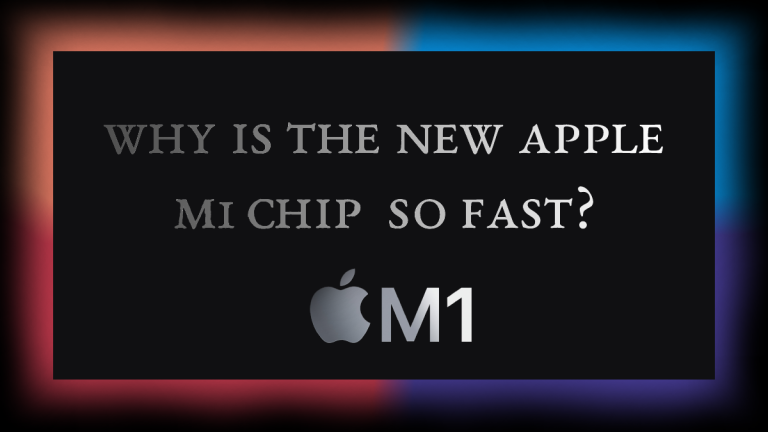Ever since the M1 devices started rolling out, critics and reviewers have been lauding the new chip like anything. It has beat just about every consumer in existence, and by a wide margin. Experts have been doing a lot of analysis on how Apple managed to just blow everything else in existence out of the water. The answers are a bit technical so let’s try to break it down to layman’s terms. (If you do want something very in-depth, check out this detailed breakdown)
Let’s look into exactly how fast the M1 chips are, how was Apple and no one else able to do it, and how exactly did they manage to do it?
Exactly how fast is it?
Until last year, Apple was using Intel chips for MacBooks. They’ve also been using in-house chips for iPhones and iPads, and this year they made the move for MacBook Air, MacBook Pro, and the Mac Mini.
If you google this question, you’ll get a ton of graphs and charts about clock frequencies and what not. In fact Intel itself came with its own set of benchmarks claiming its i7 processors beat M1 in almost everything, except the battery life in which they grudgingly admitted a 1% edge for the M1.
Let’s make it simple. It’s fast. It’s faster than just about anything except the i9, which costs almost as much(or more than) a MacBook. And the battery performance is amazing.
The magic really is that all of this performance and all of this efficiency comes without noisy cooling or extra weight. Sure that’s not all Apple magic, Intel doesn’t have control all over how laptop OEMs choose to handle the heat. But when laptops that offer that level of performance are usually bulky beasts, you’ve gotta hand it to Apple.
But there’s a really quick way to see how these perform, all other things being almost the same. Apple still sells Intel powered Mac Minis and MacBooks. Sure, when you bring in a new model, there’s bound to be upgrades other than the chip. But go to YouTube, and you’ll find videos in which basic M1 Mac Minis are destroying maxed out Intel Mac Minis.
And things only get worse for the Intel ones when you get to MacBook Pro and MacBook Air.
So there you go. It’s fast.
Now of course you may be thinking, well, Intel processors are x86, M1 is ARM, apples and oranges….
Well without going into a lot of detail, M1 beat the SQ, the chip on ARM Surface Pro, by a very huge margin.
Why is no one else able to do this?
Once we go through the technical nitty gritty of the chip itself, this is the question that comes up. Why is Intel not doing this same thing? Why is AMD not doing this?
In some ways, you can compare Apple vs Intel to iOS vs Android. For an Apple product, they make the OS, design the hardware, and make the chip too. In the case of Intel or AMD, they have control over the chip only. And every laptop OEM has different things in their mind when they make their individual products. Some laptops are for gaming, some are for business, some are meant to be lightweights. And they all come at different price points. So chipmakers need to make chips that work for all of them. So the chips are general purpose, and the OEMs make the overall device more towards their specifications or use case.
As you can imagine, when you build something from the ground up with a clear specific requirement, things tend to work really well. And that’s really not an option for other players. Well Intel (and other chipmakers) could in theory start making their own laptops. But then Intel will have to focus all their energy into something they don’t have a lot of experience in, and lose out on something they are making money on. Catch-22?
ARM vs x86
Another Catch-22 for Intel is that they’re all about x86 architecture, while M1 is ARM based. In simple terms, x86 and ARM are what you call ISA or Instruction Set Architecture or ISAs. These ISAs determine how the processors carry out instructions in a program.
ARM processors have ISAs with a simple and lesser number of instructions and fall into a category called RISC processors. That’s a term you’ll come across a lot if you read about M1 chips. It stands for Reduced Instruction Set Computing.
Intel processors have a more complex and larger number of instructions. And they are what you’d called CISC or Complex Instruction Set Computing.
So Intel – x86 – CISC – complex, large number instructions
M1 – ARM- RISC – simple, small number of instructions.
Since ARM is simple, it means less power consumption. And less transistors on chip. Or rather more space for more components. That’s why ARM has been just killing it out in the mobile world. Less power consumption, and more components on the chip. Not just the CPU, but the GPU, the memory, and more on a single chip. Actually, an entire System on Chip.
Heard about the Qualcomm SnapDragon SoC? Yep, ARM based, System on Chip.
Now Intel is a major player in x86. And if they were to move on to ARM, it will put their position in X86 in jeopardy. And if they don’t, well…..
How is the M1 chip so fast
As mentioned above, M1 is an SoC. And sure it has a CPU, and a GPU. But it doesn’t stop there. It has an ISP ( An Image Processing Unit, not an internet service provider), it’s got a secure enclave for the encryption, authentication, and things like that, and it’s got an NPU or a neural processing unit. It’s digital signal processor handles mathematically intensive functions. And it’s got a video encoder/decoder. This is an approach seen on many smartphones, it’s got separate chips for AI, for image processing, for photography, and others.
All of these specialised chips mean they’re all really good at what they’re supposed to do, unlike one chip trying to do everything. This gives M1 a huge edge.
The M1 chip also has a Unified Memory on it.
Most people, and with good reason, take the words “Integrated Graphics” as no graphics.
Now Apple has with all their technological goodness has made this actually work. And unified memory is what makes it happen. It serves memory to both the CPU and GPU and it does that really well. By creating a memory that is fast, and can serve large quantities of it, both the CPU and GPU can use the same memory, instead of separate ones. Or without becoming slow. They did this by integrating the RAM on the SoC.
This is of course a massive oversimplification, Apple has had to overcome a lot of technical challenges to accomplish this, for example the massive heating problem of the GPUs. But yeah this is pretty much how its fast.
This does mean users won’t be able to upgrade their RAM. But hey we’re all kinda used to RAM soldered onto the CPU, so.
The M1 CPU cores
The M1 chip has 8 cores, 4 performance cores called Firestorm, and 4 efficiency cores called Icestorm. The arrangement makes the chip power efficient when running apps that don’t need too much ‘fire’power, but ready to deliver when asked for the extra oomph. The arrangement is not new, it is often seen in smartphones and the ARM processor in the Surface Pro, the SQ2 has 4 Qualcomm Kryo 495 Silver @ 1.80 GHz energy-efficient cores, and 4 Qualcomm Kryo 495 Gold @ 3.14 GHz.
And the Firestorm cores have beaten Intel and AMD cores. And it’s a lot cooler. AMD’s Zen3 kinda beats them, but it takes a lot more power to achieve this.




